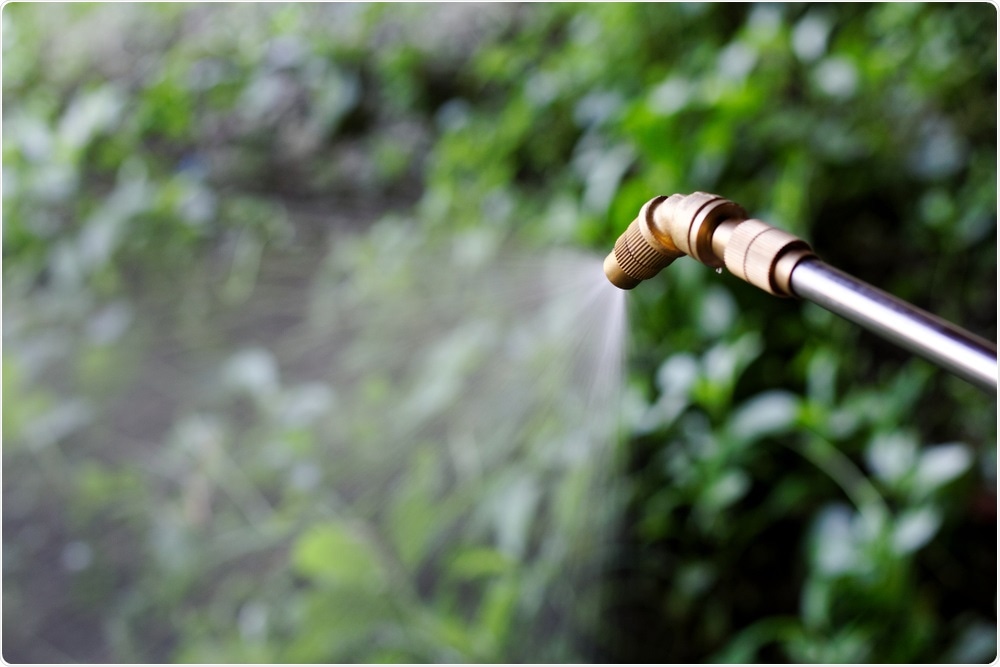An herbicide extensively used in forestry, agriculture, and other applications can significantly impact the reproductive health of a common perennial plant that grows in forests in British Columbia, Canada.

Herbicide. Image Credit: Kritchai7752/Shutterstock.com
According to researchers, glyphosate-based herbicides (GBH) affected the numerous reproductive organs on prickly rose (Rosa acicularis) a year after the chemicals were initially sprayed in both experimental plots and field locations. The study was published in the Frontiers in Plant Science journal.
This research work is one of the first to investigate the effects of GBH on the reproductive morphology of a common perennial plant in a commercial forestry operation. This pesticide is often used to manage weeds that may compete with conifers generally cultivated in regions called “cutblocks.” Although glyphosate has been used since the 1970s, it was only recently that it came into observation, owing to concerns about its carcinogenic effects on human health.
The researchers from the University of Northern British Columbia (UNBC) obtained and examined samples of prickly rose reproductive components from three cutblocks, and also from greenhouse-grown wild plants. They subsequently compared these samples to untreated plants from analogous sources.
The results were remarkable: A year after the initial application, the pollen viability of plants treated with glyphosate fell by an average of 66% when compared to controls. Over 30% of anthers, the portion of the stamen containing pollens, failed to split apart (a process called dehiscence), relegating these flowers to functional sterility. Furthermore, the team detected GBH residues on plant blooms two years after the herbicide was initially applied.
The changes to plants have been documented in the past, in agricultural plants, so it is not surprising to find them in forest. What is important is the timeline. To continue to find these effects one to two years after herbicide applications, in new parts of growing plants, is noteworthy.”
Dr Lisa J. Wood, Assistant Professor, Department of Ecosystem Science and Management, University of Northern British Columbia
For many years, indigenous people have utilized prickly wild rose as both medicine and food, specifically the reproductive portions. R. acicularis is also a significant plant in terms of ecology, because it supplies food for pollinators. Honeybees, for instance, are drawn to specific hues exhibited by flowers.
Wood and Alexandra Golt, the study lead author and a UNBC graduate student, detected color changes in anthers and flower petals of the treated plants. These color abnormalities may have an impact on the interaction between pollinators and flowers.
According to Wood, a follow-up analysis will look at whether the color changes in the GHB-treated flowers render them more or less appealing to pollinators. The team will also examine the feces of hummingbirds and pollinating insects for the presence of glyphosate residue.
This will tell us if pollinators are taking up residues from the plants they feed on. We will also research other plants to see if the changes we observed in the wild rose are also found in other flowers.”
Dr Lisa J. Wood, Assistant Professor, Department of Ecosystem Science and Management, University of Northern British Columbia
Wood explained that while previous studies have shown that glyphosate is not acutely toxic to a majority of organisms at the levels used commercially in Canada, scientists do not know much about the long-term effects of glyphosate use or how it affects the dynamics of the natural environment, such as available food quality or species interactions.
The more we learn the better, and research can always be used to better inform management. Herbicide practices may change, if the research shows that this is in the public's best interest.”
Dr Lisa J. Wood, Assistant Professor, Department of Ecosystem Science and Management, University of Northern British Columbia
Source:
Journal reference:
Golt, A R & Wood, L J (2021) Glyphosate-Based Herbicides Alter the Reproductive Morphology of Rosa acicularis (Prickly Rose). Frontiers in Plant Science. doi.org/10.3389/fpls.2021.698202.